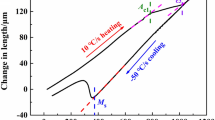Abstract
The temper-aging response of a 0.05 pct C plain carbon dual phase steel was studied in order to understand the metallurgical aspects of the overaging cycle of a continuous annealing process. Four regimes can be distinguished during the isochronal temper-aging depending upon the temperature. Below 225 °C (regime I), the yield strength and yield point elongation(YPE) increase with temperature while the tensile strength changes insignificantly. In regime II (~225 to 350 °C), both the yield and tensile strength decrease rapidly with temperature whileYPE remains constant. In regime III (~350 to 535 °C), the tensile strength continually decreases with temperature but yield strength shows either a plateau or peak. TheYPE rises again with temperature in this stage. Above 535 °C (regime IV), the yield and tensile strength andYPE all drop again with temperature. The isothermal temper-aging behavior was also studied and it is found that at room temperature both yield and tensile strength increase with time. At higher temperatures, however, the tensile strength decreases with time but yield strength increases initially then drops with time. The change of properties during the isochronal and isothermal temper-aging is explained in terms of the microstructural changes in ferrite and martensite.
Similar content being viewed by others
References
K. Araki, S. Fukunaka, and K. Uchida:Trans. ISIJ, 1977, vol. 17, p. 701.
K. Matsudo, T. Shimomura, K. Osawa, T. Okuyama, M. Kinoshita, and S. Osaka: NKK Technical Report, Overseas No. 29, 1980, p. 1.
P.R. Mould:J. of Metals, 1982, vol. 34, no. 5, p. 18.
M. S. Rashid and B. V. N. Rao: “Fundamentals of Dual-Phase Steels,” R. A. Kot and B. L. Bramfitt, eds.,AIME Conference Proceedings, 1981, p. 249.
R.G. Davies: “Fundamentals of Dual-Phase Steels,” R. A. Kot and B.L. Bramfitt, eds.,AIME Conference Proceedings, 1981, p. 265.
G. R. Speich and R. L. Miller: “Fundamentals of Dual-Phase Steels,” R. A. Kot and B. L. Bramfitt, eds.,AIME Conference Proceedings, 1981, p. 279.
G. R. Speich and W. L. Leslie:Metall. Trans., 1972, vol. 3, p. 1043.
R.N. Caron and G. Krauss:Metall. Trans., 1972, vol. 3, p. 2381.
A.S. Keh and W.G. Leslie:Materials Science Research, H.H. Stadelmaier and W. W. Austin, eds., Plenum Press, New York, NY, 1963, vol. 1, p. 207.
J. F. Enrietto, M. G. H. Wells, and E. R. Morgan:Precipitation from Iron-Base Alloy, G.R. Speich and J.B. Clark, eds., Gordon and Breach, New York, NY, 1965, p. 141.
J. D. Baird:Met. Review, 1971, vol. 16, p. 1.
E. O. Hall:Yield Point Phenomena in Metals and Alloys, Plenum Press, New York, NY, 1970.
P.D. Southwick: Internal Report, Inland Steel Company, Research Department, East Chicago, IN, June 1981.
G.B. Olson and M. Cohen:Metall. Trans. A, 1983, vol. 14A, p. 1057.
Author information
Authors and Affiliations
Rights and permissions
About this article
Cite this article
Chang, PH. Temper-Aging of Continuously Annealed Low Carbon Dual Phase Steel. Metall Trans A 15, 73–86 (1984). https://doi.org/10.1007/BF02644389
Received:
Published:
Issue Date:
DOI: https://doi.org/10.1007/BF02644389



